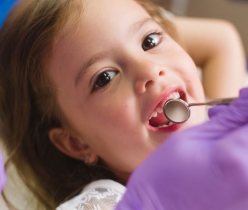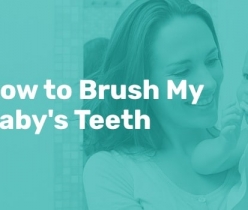When is the Best Time to Start Flossing Your Children’s Teeth
Many parents ask “when is the best time to start flossing our kid’s teeth?” Great question! Flossing is an important oral hygiene habit that we encourage to start early. Once the teeth start to touch, bacteria and plaque can build up in between these teeth and can start causing cavities or gum disease. So, if you can’t see visible spaces in-between your child’s teeth, then it is time to start flossing! It is important to note that flossing can be introduced, even if your child has ample space in between the teeth, as a good way to desensitize the action and make it part of each child’s oral hygiene routine. In fact, many parents find it easier to floss their children’s teeth if spaces are present so this is a fabulous way for kids to get used to the routine in a low stress environment. Early prevention and establishing good oral hygiene habits at a young age is key!
Why Should Children Floss
Flossing is the way we clean the area between our teeth. It doesn’t matter if it’s a baby tooth or a permanent tooth, flossing is the best method to keep the surfaces between the teeth clean. A tooth brush alone does not remove the plaque and bacteria that resides in between the teeth. Without proper flossing, your child will be at a higher risk for developing cavities and gingivitis.
How to Floss Your Baby’s Teeth
We always say, “Flossing is a marathon, not a sprint!” This is so true! It’s important to start slow and set manageable expectations and goals, especially for the youngest of patients. Don’t make it overwhelming or frustrating. Start with an easy-to-see area of the mouth and only try to floss a couple of teeth at the beginning. This way you won’t get frustrated, which could make it uncomfortable for the child. Then work on adding a new spot each night, and work towards the goal of being able to floss the whole mouth in one sitting! This helps build the habit into your child’s routine without being overwhelming. It’s important that it feels manageable to both parents and kids.
Types of Floss & Flossers for Children
First, pick the right type of floss that works best in your hands. Traditional floss or flossers with handles are great options. When using flossers with handles, it is important to note that trauma can be caused to the gums if used improperly. When using the flossers, make sure not to snap the floss into the gums, and aim to “hug” the tooth when flossing. For younger children we recommend that an adult helps floss. You can floss at any time of the day, but most families find it easiest to incorporate flossing into the bedtime routine. Having your child lay down makes getting the flossers or traditional flossing into the right spots more accessible.
What About Using a Waterpik or Other Water Flossers
While these are fun gadgets that can help motivate oral hygiene for some patients, they still don’t compare to good ‘ole traditional flossing. Water flossers are good adjuncts to flossing, but shouldn’t replace it entirely. Water flossers are great for removing larger pieces of food debris, but not as effective at removing plaque. Plaque is “stuck” on the teeth rather tightly, and water flossers may not produce enough force to remove all the layers of plaque. If you like to use a water flosser, stick with it, but just make sure you still floss afterward.
If you have any questions or concerns about your child’s teeth or oral hygiene practices, give us a call at 503-477-9911 to schedule an appointment.

Dr. Dana grew up in Portland and went to Temple University in Philadelphia, PA for dental school. She then moved to Anchorage, AK for her residency in Pediatric Dentistry. Dr. Dana takes a holistic approach to pediatric dentistry & is able to use her own parenting experience to sympathize and understand each family’s unique dynamic.




